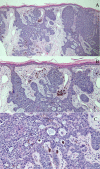Basal Cell Carcinoma of the Umbilicus: A Comprehensive Literature Review
- PMID: 27738570
- PMCID: PMC5059144
- DOI: 10.7759/cureus.770
Basal Cell Carcinoma of the Umbilicus: A Comprehensive Literature Review
Abstract
Basal cell carcinoma (BCC) typically occurs in sun-exposed sites. Only 16 individuals with umbilical BCC have been described in the literature, and the characteristics of patients with umbilical BCC are summarized. PubMed was used to search the following terms: abdomen, basal cell carcinoma, basal cell nevus syndrome, and umbilicus. Papers with these terms and references cited within these papers were reviewed. BCC of the umbilicus has been reported in five men and 11 women; one man had two tumors. Two patients had basal cell nevus syndrome (BCNS). Other risk factors for BCC were absent. The tumor most commonly demonstrated nodular histology (64%, 9/14); superficial and fibroepithelioma of Pinkus variants were noted in three and two patients, respectively. The tumor was pigmented in eight individuals. Treatment was conventional surgical excision (87%, 13/15) or Mohs micrographic surgery (13%, 2/15); either adjuvant laser ablation or radiotherapy was performed in two patients. The prognosis after treatment was excellent with no recurrence or metastasis (100%, 16/16). In conclusion, BCC of the umbilicus is rare. It usually presents as a tumor with a non-aggressive histologic subtype in an individual with no risk factors for this malignancy. There has been no recurrence or metastasis following excision of the cancer.
Keywords: basal cell carcinoma; umbilicus.
Conflict of interest statement
The authors have declared that no competing interests exist.
Figures


References
-
- Basal cell carcinoma: pathogenesis, epidemiology, clinical features, diagnosis, histopathology, and management. Marzuka AG, Book SE. http://www.ncbi.nlm.nih.gov/pmc/articles/PMC4445438/ Yale J Biol Med. 2015;88:167–179. - PMC - PubMed
-
- Basal cell epitheliomas in usual and unusual sites. Rahbari H, Mehregan AH. J Cutan Pathol. 1979;6:425–431. - PubMed
-
- Basal-cell carcinomas on covered or unusual sites of the body. Robins P, Rabinovitz HS, Rigel D. J Dermatol Surg Oncol. 1981;7:803–806. - PubMed
-
- Basal cell carcinomas of covered and unusual sites of the body. Betti R, Bruscagin C, Inselvini E, Crosti C. Int J Dermatol. 1997;36:503–505. - PubMed
-
- Basal cell carcinoma of the axilla: review of the world literature. Cohen PR. Am J Clin Dermatol. 2014;15:95–100. - PubMed
Publication types
LinkOut - more resources
Full Text Sources
Other Literature Sources
